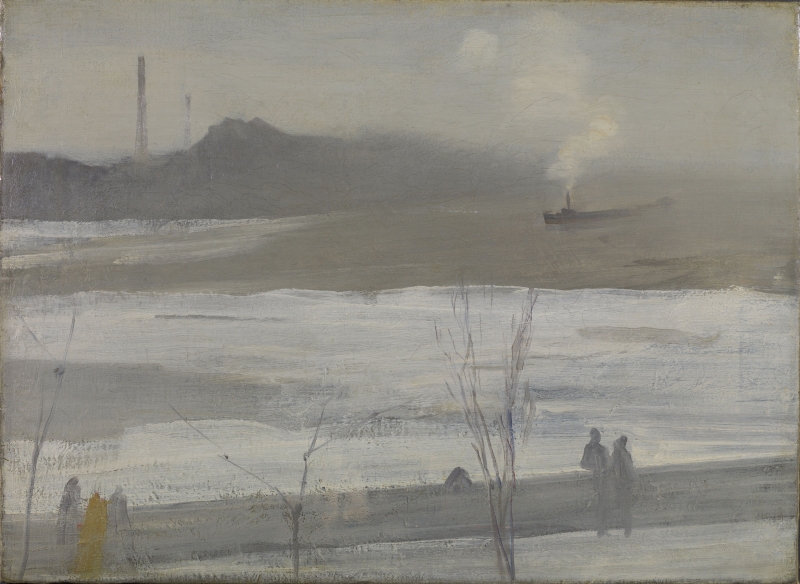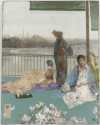Titles
Several possible titles have been suggested:
- 'Harmony in grey. Chelsea in ice' (1887, Royal Society of British Artists). 1
- 'the Ice Picture ... Ice in the Thames' (1887, Whistler). 2
- 'Chelsea Winter' (1892, Whistler). 3
- 'Chelsea in Ice' (1892, Goupil). 4
- 'Chelsea in Ice' (1980, YMSM). 5
'Chelsea in Ice' is the generally accepted title.
Description
A cityscape in horizontal format, looking across a river. There are wide rafts of snow and ice floating down the river. In the foreground there are people walking along the pavement by a wall above the shore, and a young leafless tree to right of centre. In the river at upper right is a steamboat making its way downriver to left. Beyond, on the far bank, are warehouses, factories, slag heaps and - at left - two factory chimneys.
Site
The view is of Battersea from Chelsea (see Grey and Silver: Old Battersea Reach [YMSM 046]).
The view of Battersea Reach on the river Thames, London, from Whistler's house in what is now Cheyne Walk, Chelsea, is seen in many of Whistler's paintings of the 1860s and 1870s (Grey and Silver: Old Battersea Reach [YMSM 046], Grey and Silver: Chelsea Wharf [YMSM 054], Battersea Reach from Lindsey Houses [YMSM 055], Variations in Flesh Colour and Green: The Balcony [YMSM 056], Sketch for 'The Balcony' [YMSM 057], and Study of Draped Figures [YMSM 058]), as well as in later Nocturnes such as Nocturne in Blue and Silver [YMSM 113], Nocturne [YMSM 114], Nocturne: Blue and Silver - Battersea Reach [YMSM 119], and Nocturne: Battersea [YMSM 120].
Comments
Lochnan suggested that 'the flatness of the composition, the simplification of form, the diagonal band formed by the wall, and the small foreground trees may have been suggested by the Japanese prints that Whistler was collecting.' 6 In addition, this work was compared with that of Claude Oscar Monet (1840-1926), whose Ice floes on the Seine at Bougival (Musée du Louvre) dates from 1867/1868, with the comment that Monet could have seen Whistler's The Thames in Ice [YMSM 036] in Paris in 1867. 7
Comparing Chelsea in Ice [YMSM 053] to George Inness's The Valley on a Gloomy Day, Justin McCann of Colby College Museum of Art blogged:
'According to [Whistler's mother's] letter, the winters in England were “penetrating” and the wintry fogs were “gloomy.” Whistler captures both sentiments in Chelsea in Ice. The grey and white color scheme give the picture a feeling of cold and gloom. Barren trees line the river bank and a steam powered passenger ship navigates through the ice that zig-zags across the river. In the distance is a grey solid mass of factories along the Battersea shore, underscoring the bleak, frigid conditions. In the foreground pedestrians stop on the Chelsea side of the river to admire the spectacle of a frozen Thames, a rare occurrence … Chelsea in Ice exemplifies Whistler’s use of atmospheric conditions in his art. He found in a wintry fog and an icy river visual effects that he could explore in his painting. Whistler wasn’t interested in registering exactly how the river looked iced over as much as he was in capturing the feeling and mood of a deep freeze that penetrated the body. The painting symbolizes a transitional moment in Whistler’s painting practice as he moved away from Realism toward Aestheticism, epitomized in his famous Nocturnes associated with the same stretch of the Thames as Chelsea in Ice. Across from Chelsea in Ice in the gallery is George Inness’ The Valley on a Gloomy Day, another work by an American painter interested in capturing the mood and tone of a day. Not only do Whistler and Inness capture the visual effects of weather, but the psychological dimensions of it as well. Whistler’s Chelsea in Ice produces the sensation of a bone-chilling day spent along the river that is experienced physically and psychologically.' 8
Notes:
1: 64th Annual Exhibition, Royal Society of British Artists, London, 1887 (cat. no. 165).
2: Whistler to E. Venturi, 14 March 1887, GUW #06001.
3: Whistler to D. C. Thomson, [4/11 January 1892], GUW #06795.
4: Nocturnes, Marines & Chevalet Pieces, Goupil Gallery, London, 1892 (cat. no. 3).
5: YMSM 1980 [more] (cat. no. 53).
6: Exhibition catalogue London 2004 [more] (cat. no. 34).
7: Ibid. (cat. no. 35).
8: 23 January 2015, The Lantern, Colby College Museum of Art.
Last updated: 6th February 2021 by Margaret










